Six top shrubs for late season colour
The value of shrubs in a garden has somewhat been forgotten over the last few years. The focus has been on perennials, annuals, bulbs and grasses.
But shrubs are so easy care. They add height, interest and permanent structure in the garden. They can be used as a screen, to anchor a border, or as part of a low maintenance garden.
They’re also brilliant for wildlife. Evergreen shrubs help provide shelter in the winter. Shrubs with flowers help pollinators in spring. And berries feed birds and other wildlife in autumn and winter.
And many deciduous shrubs add glorious late season colour to the garden as their leaves change colour. If you don’t have much tree foliage in the garden, the right shrubs can transform your autumn garden.
So I went to Gravetye Manor Hotel, which has one of the most beautiful gardens in Britain, to ask head gardener, Tom Coward for six really good shrubs with autumn colour for small gardens.
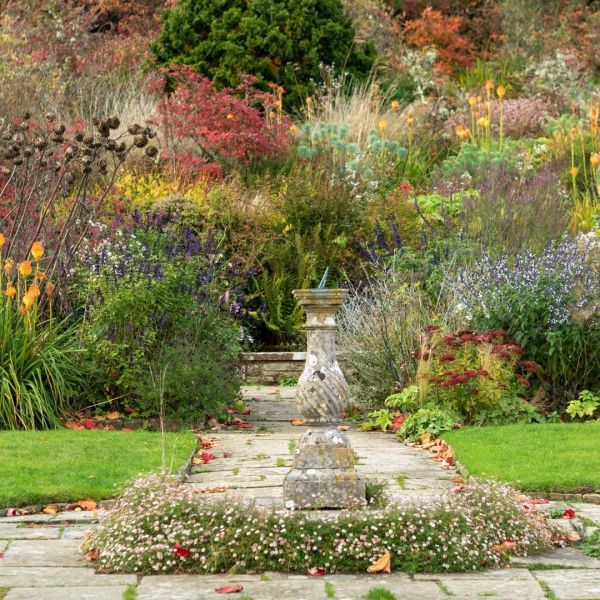
The stunning late season borders at Gravetye Manor.
Gravetye Manor Hotel gardens
Gravetye Manor gardens were designed by William Robinson in late Victorian times. He is variously called the grandfather of today’s domestic gardening and ‘the Irishman who taught the English how to garden.’ Robinson pioneered many elements that we use in our gardens today – such as the herbaceous border and the wild garden.
Today Gravetye Manor is a hotel with the most delicious, award winning food and the gardens are run by Tom Coward.
Tom says he gardens ‘in the spirit of William Robinson’, which means continuing to try different plantings and approaches while also cherishing some of the plants William Robinson would have known.
There’s more about a summer visit I made to the gardens at Gravetye Manor here.
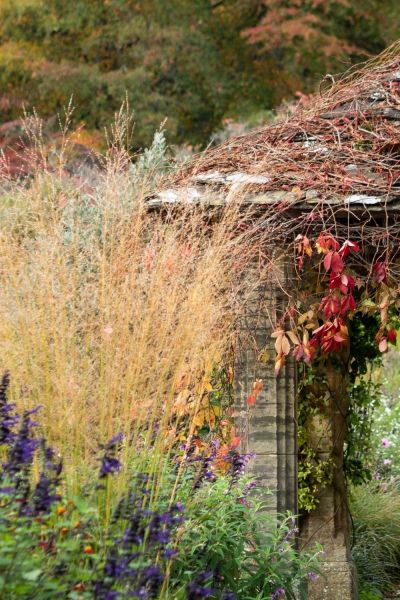
Autumn grasses and climbers near the porch at Gravetye Manor
Plants often have different common names in different places but the botanic names are understood all over the world. So use them to check you’re getting the right one for your garden. I don’t personally find understanding the botanic names easy, but I find it helps to copy and paste them into a search engine when looking for plants.
Tom says that it’s difficult to name just six good shrubs for late season colour because there are so many brilliant shrubs and it’s such a wonderful time of year. But here are his suggestions.
Six shrubs with beautiful late season colour…
- Downy Japanese maple ‘Aconitifolium’ (Acer japonica ‘Aconitifolium’)
- Winged spindle (Euonymus alatus)
- Yellow azalea (Rhododendron luteum)
- Snowball bush (Viburnum opulus)
- Cornus, also known as dogwoods (Cornus alba, Cornus stolonifera)
- Blueberries
Japanese maple for blazing red foliage
Acer japonica ‘Aconitifolium’ can be a small tree or a large shrub. Tom picked it because it also has beautiful spring flowers and foliage. He recommends picking shrubs that have two seasons of interest.
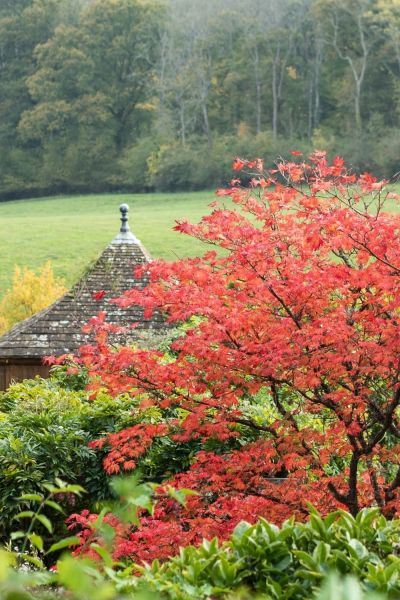
Acer japonica ‘Aconitifolium’ can be grown as a small tree or a large shrub.
Like most acers, it will be best in a sheltered spot. Don’t use acers as wind breaks! It will be happy in partial shade, which makes it a good small tree for a city garden. They’re easy to look after as they don’t need much pruning – just a bit of light shaping in late winter or early spring. If you have dry summers, water it weekly, especially in the first few years after planting.
See here to find out how to choose and plant a tree for good late season colour in small gardens.
Winged spindle or Burning bush
When we got out of the car at Gravetye Manor, we were immediately astonished by a beautiful winged spindle (Euonymus alatus) blazing opposite the front door. It was an almost Schiaparelli pink. This plant is now on my shopping list, along with its cousin, Euonymus Europeaus ‘Red Cascade’, which we spotted elsewhere in the gardens.
Winged spindle euonymus is also known as Burning bush. This is another very easy shrub to grow, to the extent that in a few parts of the United States, such as New Hampshire, it is banned as an invasive species. But here in the UK and in other parts of the world, it’s not invasive.
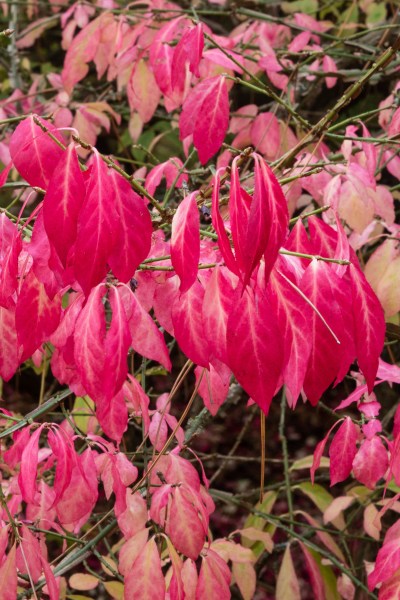
The amazing late season foliage of Winged Spindle.
It also only needs light shaping in late winter or early spring. It’ll be happy in either full sun or partial shade and will grow in either exposed or sheltered situations. So it’s very easy and very dramatic. It has little white flowers in spring and yellow or purple fruits in autumn plus those spectacularly pink leaves.
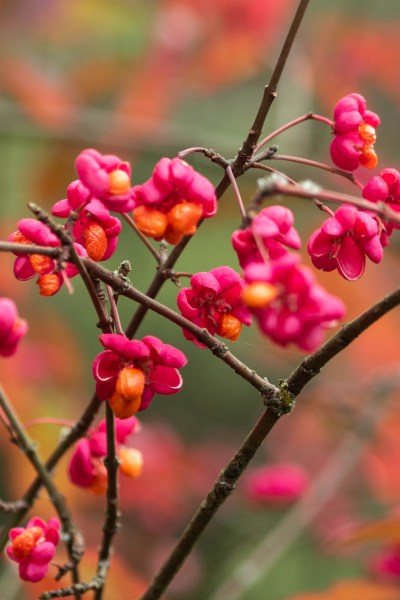
Euonymus Europaeus ‘Red Cascade’ also has amazing late season interest.
A word about invasive plants
Any plant which is very easy to grow has the potential to become invasive if it’s grown in a different environment. The line between ‘easy to grow’ and ‘invasive’ is sometimes quite blurred. So a plant that is merely easy to grow in Britain, such as the Winged spindle/Burning bush, grows too well in several parts of the United States. This means that it can out compete native plants and affect the biodiversity of the area.
In the UK, there is a list called Schedule 9 of the Wildlife & Countryside Act. It is illegal to grow the plants on it in the wild and, in the case of some plants, such as Japanese knotweed, it’s illegal to grow them at all.
However, many of the plants on Schedule 9 are still sold by the RHS and other reputable sellers. You are allowed to grow them in your garden, but you must not allow them to spread out of your garden.
It’s important to check which plants are either illegal or restricted where you live. There are no ‘bad plants’, just a few bad places to plant them!
Yellow azalea
Yellow azalea or Rhododendron luteum has beautiful blazing yellow flowers and rich autumn leaf colour. This is another shrub which is so easy to grow that it’s considered invasive in some places. My parents lived in Surrey, which has very poor sandy acid soil and almost the only plants that would grow were rhododendrons, camellias and azaleas. We loved their brilliant flowers in spring.
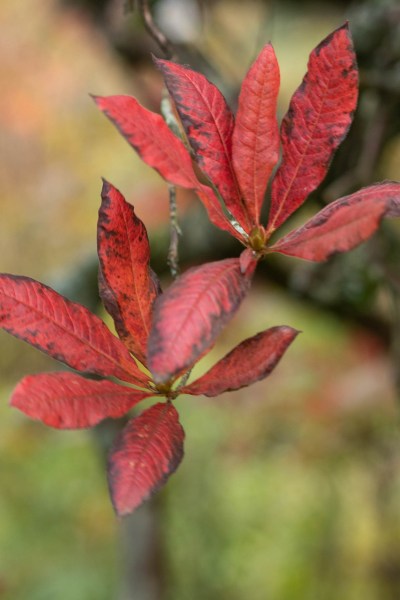
Yellow azalea has brilliant spring flowers and rich autumn colour.
So it has an important part to play, and is still widely sold and planted by reputable sellers, including the RHS. But it is restricted to gardens as it is on Schedule 9 of the Wildlife & Countryside Act. You can grow it in your garden but don’t allow it to spread into any countryside beyond.
Snowball bush
Snowball bush or Viburnum opulus is such a pretty shrub in spring, too. It has beautiful white pom pom flowers. It’s another super-obliging plant and will grow in any aspect – north, south, east or west. And then it has gorgeous autumn colour and often pretty berries too.
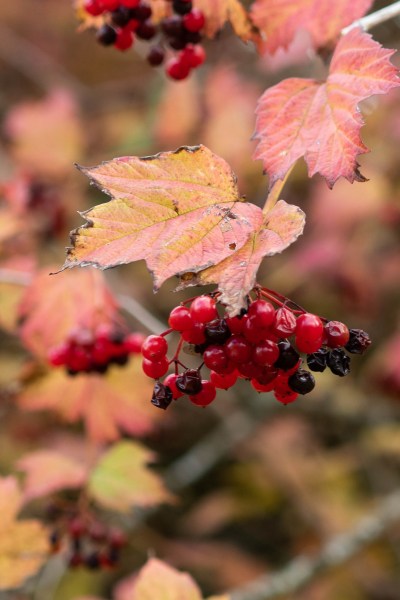
Snowball bush has beautiful white flowers in spring, then pretty autumn colour and berries.
If you have a small garden, Tom recommends looking for the compact version. Many larger shrubs today have smaller varieties for smaller gardens and these will be called ‘Compacta’ or compact. Generally it’s a good idea to check the final height of shrubs on the label before buying. There are Viburnum opulus ‘compacta’ as well as a compact variety of winged spindle.
Cornus
Cornus are commonly known as dogwoods and they are a group of around fifty trees and shrubs. On the whole, it’s important to decide whether you want your cornus for autumn and winter interest, such as Cornus alba, which Tom recommended. Or you could choose your cornus for its flowering gorgeousness in spring, such as Cornus ‘Norman Haddon’ seen here in garden designer Posy Gentles’ garden.
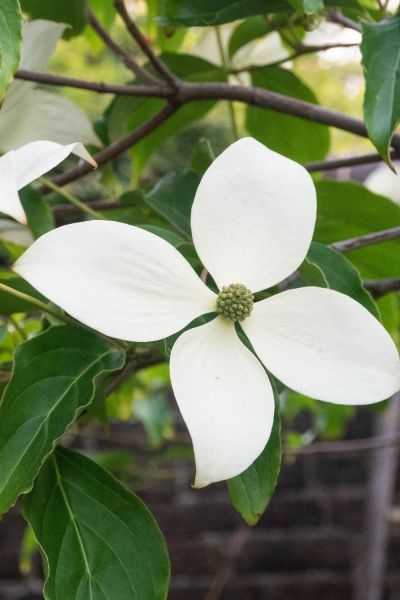
Cornus ‘Norman Haddon’ has beautiful white spring flowers
I haven’t personally seen a cornus which has both outstanding spring flowers and autumn colour, though do let me know if you have. The cornus that are grown for winter interest have beautiful coloured stems in blazing reds, oranges and yellows. But Tom points out that these also have brilliant late season foliage too. ‘The red stemmed cornus have red autumn foliage,’ he says. ‘And the yellow stemmed cornus have yellow autumn foliage.’
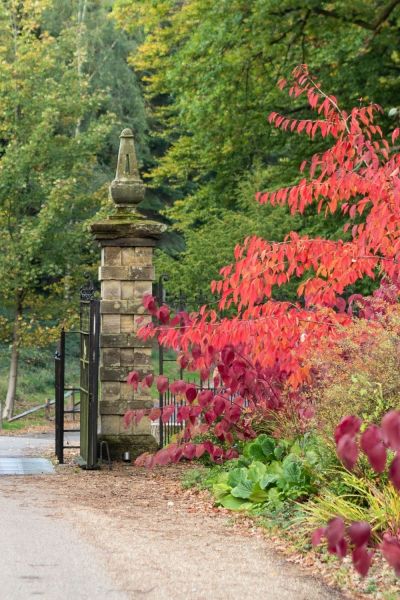
A row of colourful cornus on the driveway at Gravetye Manor Hotel.
There was a beautiful group of cornus in the driveway at Gravetye, looking stunning. Later on in the winter, they’ll be looking just as good with their brightly coloured bare stems.
Blueberries
Most of us think about growing blueberries for their fruit but Tom pointed out that they make beautiful garden bushes too. They have very pretty flowers in spring, attractive berries and gorgeous autumn leaves.
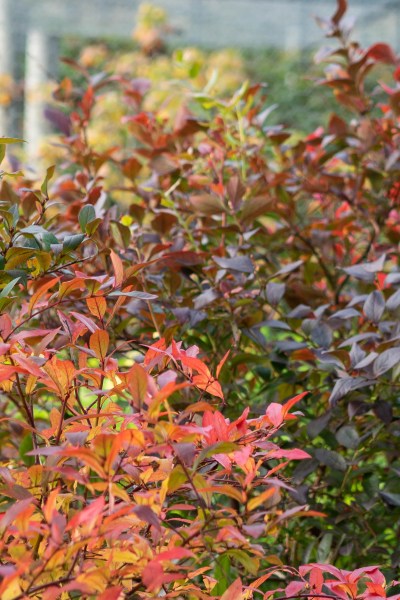
Two blueberry bushes at different stages of changing colour.
However, they’ll probably only grow well in your soil if it’s fairly acid – for example, if you grow rhododendrons, azaleas and camellias well, then you’ll be able to grow blue berries. Otherwise blue berries grow well in pots. Use ericaceous compost (suitable for acid loving plants).
You will probably have to decide whether you want your blueberries for their fruit, in which case you will need to net them against the birds. Or if you’d rather just enjoy their autumn leaves and berries as a decorative element in your garden, then you can allow the birds to take most of the berries.
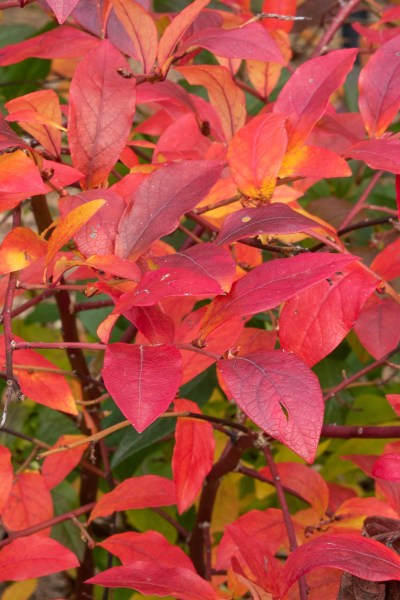
Blueberry bush leaves changing colour for autumn.
More about Gravetye Manor Hotel
If you’re staying or eating at the hotel, you can book a garden tour on certain days. It’s a one hour tour with a member of the gardening team.
The manor itself dates back to 1598, so many of the rooms are delightfully historic. But a new restaurant, made with glass walls, means that you feel you are eating in the garden even in the depths of winter. William Robinson also owned much of the land around it, now owned by the Forestry Commission, so Gravetye Manor is set in glorious views of rolling countryside.
There are some lovely views of this really outstanding garden in this video here:
Shop my favourite gardening products, books and tools
I’m often asked for recommendations so I’ve made lists of the gardening products, books and tools I use myself on the Middlesized Garden Amazon store. Note that links to Amazon are affiliate, so I may get a small fee if you buy but it won’t affect the price you pay. And I only recommend products I use myself.
You can still buy some of William Robinson’s books today. For example, The Wild Garden has been re-issued, with extra material written by Rick Darke to explain why Robinson is so relevant to today’s gardening.
And The English Flower Garden has also been re-issued as a Bloomsbury Classic.
Shrubs are very low maintenance. All they need is a once-yearly pruning, but it’s a good idea to make sure you’re pruning properly. The RHS Pruning & Training Guide: What, Where and How to Prune is a good all round guide.
Pin to remember shrubs for autumn colour
And do join us every Sunday morning for more gardening tips, ideas and inspiration. See how to follow by email here.
























